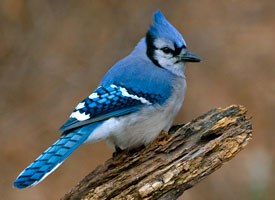A few weeks back, one of my classes held in the performance studio (a room
with a wall of windows which floods the room with natural light) was graced with the presence of a blue jay! Though I wasn’t able to get a photo of it, the bird was so beautiful and rare to my eyes that I had to include it in this blog.
Blue jays are actually fairly common in suburban areas, especially near oak trees or bird feeders. The blue jay’s diet is fairly varied. They eat insects, nuts and seeds, grains, dead or injured small vertebrates, and are even known to steal the eggs of other birds!
suburban areas, especially near oak trees or bird feeders. The blue jay’s diet is fairly varied. They eat insects, nuts and seeds, grains, dead or injured small vertebrates, and are even known to steal the eggs of other birds!
These songbirds are fairly complex. They have intricate social systems and are known for their intelligence. Blue jays mate for life and form tight family bonds. They have a large ‘vocabulary’ and have been known to imitate human speech and cats’ meows. In the wild, they frequently mimic hawks, either to warn other blue jays of the presence of hawks, or to trick other birds into thinking a hawk is present.
Reference and photograph source:
https://www.allaboutbirds.org/guide/Blue_Jay/lifehistory
iNaturalist Observation:










